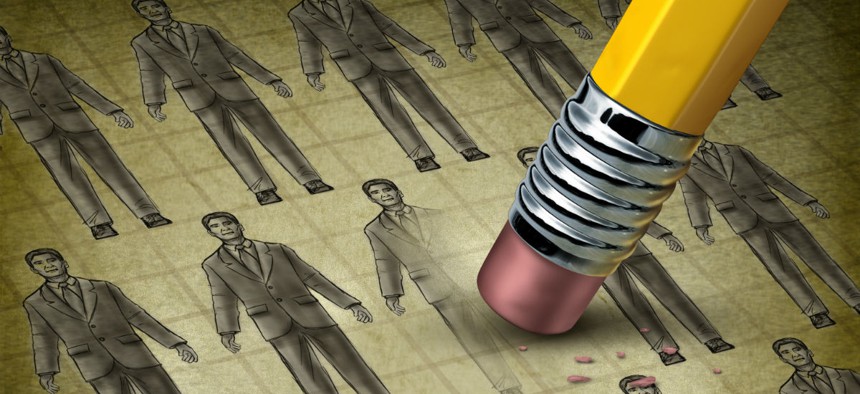There is a Precedent for Trump's Governmentwide Hiring Freeze
The president-elect could follow in Reagan and Carter’s footsteps.
Donald Trump’s pledge to freeze federal hiring on his first day in office is both possible and with precedent, and likely to have far-reaching effects on federal agencies if implemented.
President Ronald Reagan, as his first act after being sworn in as head of the executive branch -- and as legend has it, before he even left the Capitol Building following his inauguration -- signed a memorandum addressed to heads of executive departments and agencies ordering a “strict freeze” on the hiring of civilian federal employees. Reagan’s order went into effect immediately.
Trump could use Reagan’s strategy, which followed a hiring freeze set in place by President Jimmy Carter. The Georgia Democrat suspended hiring three times over his one term in office, though the final freeze over his last year in office was the most significant. Reagan said in his memo that he was issuing the freeze to follow up on a pledge he made during the campaign, just as Trump would be.
Trump made his promise in an October speech in Gettysburg, Pa., during which he rolled out his plans for his first 100 days in office. His plan would exempt jobs in the military, public safety and public health. Reagan, meanwhile, tasked his Office of Management and Budget director with issuing guidance that provided “exemptions in those rare and unusual circumstances where exemptions are necessary for the delivery of essential services.”
Max Stier, president of the Partnership for Public Service, said Trump’s proposal would carve out “well more than” half of the federal government. Indeed, civilians at just the departments of Defense, Health and Human Services, and Homeland Security Department alone make up a slight majority of the non-postal civilian workforce, and that does not account for law enforcement personnel at other agencies. The president-elect's plan does not clarify, however, whether administrative and support staff positions at health and public safety departments would also be exempt.
In a subsequent speech on the campaign trail, Trump said the hiring freeze would apply to “non-essential” personnel, perhaps a reference to the phrasing commonly used to describe which federal employees are sent home during government shutdowns. In 2013, about 900,000 employees, or 43 percent of federal workforce, was subject to furloughs.
Dan Blair, a former acting and deputy director of the Office of Personnel Management and current president and CEO of the National Academy for Public Administration, said the devil would be in the details of Trump’s plans.
“In order to not paralyze government operations, you need to build in some flexibility,” Blair said of Trump’s hiring freeze. “Some people leave that you absolutely must replace.”
He added it was unclear if Trump would build in such an “escape clause,” as Reagan did.
Stier said the hiring freeze is a half-baked idea from the get go.
“Presumably the goal is to make government more effective,” he said, adding there are a lot of ways to accomplish that but a hiring freeze is “not one of them.” He noted while the president has the power to initiate and implement a hiring freeze, it would, for example, obliterate efforts to bring new and young faces to the information technology workforce. If Congress decided to set a floor for the number of employees at various agencies, as it has for years at Customs and Border Protection, it could create a conflict with the president's order.
On top of those shortfalls, a hiring freeze may not even be an effective way to reduce costs. A 1982 General Accounting Office (now the Government Accountability Office) report on Reagan and Carter’s hiring freezes found the policy was not an “effective means” of controlling federal employment “regardless of how well managed.”
“The government-wide hiring freezes had little effect on federal employment levels and it is not known whether they saved money,” GAO said. “Because they ignored individual agencies' missions, workload, and staffing requirements, these freezes disrupted agency operations and, in some cases, increased costs to the government.”
Rather than reducing the cost on labor overall, the auditors found the administration developed “alternative sources” to get work done that increased spending.
“Any potential savings produced by these freezes would be partially or completely offset by increasing overtime, contracting with private firms, or using other than full-time permanent employees,” GAO said. “Decreased debt and revenue collections also occurred as a result of hiring freezes.”
A governmentwide hiring freeze fails to take into account actual workload, GAO said, and employee reduction should instead be “targeted to where it can best be absorbed.”
Stier acknowledged the civil service system is outdated and needs to be changed “dramatically.” More effective hiring, a market pay system and other reforms would make a much more significant impact than a freeze, he said.
Federal employee unions have blasted Trump’s plan, saying it was unnecessary, detrimental and illustrative of the president elect’s lack of understanding of how government works.








